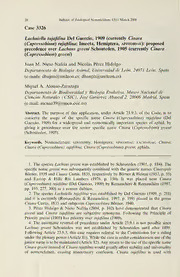
Case 3326. Lachniella tujafilina Del Guercio, 1909 (currently Cinara (Cupressobium) tujafilina; Insecta, Hemiptera, APHIDIDAE): proposed precedence over Lachnus greeni Schouteden, 1905 (currently Cinara (Cupressobium) greeni) PDF
Preview Case 3326. Lachniella tujafilina Del Guercio, 1909 (currently Cinara (Cupressobium) tujafilina; Insecta, Hemiptera, APHIDIDAE): proposed precedence over Lachnus greeni Schouteden, 1905 (currently Cinara (Cupressobium) greeni)
28 Bulletin ofZoological Nomenclature 63(1) March 2006 Case 3326 Lachniella tujafilina Del Guercio, 1909 (currently Cinara (Cupressobium) tujafilina; Insecta, Hemiptera, aphididae): proposed precedence over Lachnus greeni Schouteden, 1905 (currently Cinara {Cupressobium) greeni) Juan M. Nieto Nafria and Nicolas Perez Hidalgo Departamento de Biologia Animal, Universidad de Leon, 24071 Leon, Spain (e-mails: [email protected]; [email protected]) Miguel A. Alonso-Zarazaga Departamento de Biodiversidady Biologia Evolutiva, Museo Nacional de Ciencias Naturales (CSIC), Jose Gutierrez Abascal 2, 28006 Madrid, Spain (e-mail: [email protected]) Abstract. The purpose of this application, under Article 23.9.3. of the Code, is to conserve the usage of the specific name Cinara (Cupressobium) tujafilina (Del Guercio, 1909) for a widespread and economically important species of aphid, by giving it precedence over the senior specific name Cinara (Cupressobium) greeni (Schouteden, 1905). Keywords. Nomenclature; taxonomy; Hemiptera; aphididae; lachninae; Cinara; Cinara (Cupressobium) tujafilina; Cinara (Cupressobium) greeni: aphids. 1. The species Lachnus greeni was established by Schouteden (1905, p. 184). The specific name greeni was subsequently combined with the generic names Cinaropsis Borner, 1939 and Cinara Curtis, 1835, respectively by Borner & Heinze (1957, p. 55) and Eastop & Hille Ris Lambers (1976, p. 150). It was placed near Cinara (Cupressobium) tujafilina (Del Guercio, 1909) by Remaudiere & Remaudiere (1997, pp. 193, 277, 300) as a nomen dubium. 2. The species Lachniella tujafilina was established by Del Guercio (1909, p. 288) and it is currently (Remaudiere & Remaudiere, 1997, p. 199) placed in the genus Cinara Curtis, 1835 and subgenus Cupressobium Borner, 1940. 3. Perez Hidalgo & Nieto Nafria (2004, p. 102) have demonstrated that Cinara greeni and Cinara tujafilina are subjective synonyms. Following the Principle of Priority greeni (1905) has priority over tujafilina (1909). 4. The automatic reversal of precedence under Article 23.9.1 is not possible since Lachnus greeni Schouteden was not estabhshed by Schouteden until after 1899. Following Article 23.9.3, this case requires referral to the Commission for a ruling under the plenary power (Article 81). While the case is underconsideration use ofthe juniornameis tobemaintained (Article 82). Any return to the use ofthe specificname Cinaragreeniinstead ofCinara tujafilinawould greatlyaffect stability anduniversality of nomenclature, causing unnecessary confusion. Cinara tujafilina is used with Bulletin ofZoological Nomenclature 63(1) March 2006 29 regularity, while Cinara greeni was mentioned only in a few catalogues and papers listedin para. 1 above. A list of33 references by 54 authorsusing Cinara tujafilinaand coveringtheyears 1948-2003 isheldby theCommission Secretariat (e..g. Bodenheimer & Swirski, 1957; Patti, 1977; Watson et al., 1999; Gil et al., 2002; Wilson et al., 2003). Confusion resulting from use ofthe older name would affect current usage of Cinara (Cupressobiitm) tujafilina as a well known pest in forestry and gardening, affect- ing several species of Callitris, Chaniaecyparis, Cupressiis, Jimiperus, Thuja and Widdringtonia (Cupressaceae) used as ornamental plants (Blackman & Eastop, 1994). 5. The International Commission on Zoological Nomenclature is accordingly asked: (1) to use its plenary power to give the name tujafilina Del Guercio, 1909, as publishedinthe binomen Lachniella tujafilina, precedence overthenamegreeni Schouteden, 1905, as published in the binomen Laclmus greeni, whenever the two are considered to be synonyms; (2) to place on the Official List ofSpecific Names in Zoology the following names: (a) tujafilina Del Guercio, 1909, as published in the binomen Lachniella tujafilina, with the endorsement that it is to be given precedence over the namegreeniSchouteden, 1905, aspublished in thebinomen Lachnusgreeni, whenever the two are considered to be synonyms; (b) greeni Schouteden, 1905, as published in the binomen Lachnusgreeni, with theendorsement that itis to not to begiven priorityoverthename tujafilina Del Guercio, 1909, as published in the binomen Lachniella tujafilina, whenever the two are considered to be synonyms. References Blackman, R. & Eastop, V.F. 1994. Aphids on the world's trees. An Identification and inforimnion guide. 8, 987 pp., 16 pis. CAB International, Wallingford. Bodenheimer, F.S. & Swirski, E. 1957. The Aphidoidea ofthe Middle East. 378 pp. Weizmann Science Press ofIsrael, Jerusalem. Borner, C. & Heinze, K. 1957. Aphidina-Aphidoidea. Blattliiuse, plantlice (Aphids), pucerons (aphides) in Sorauer, P. (Ed.), Handbuch der Pflanzenkraenkheiten, 5. 4: 1^02. Del Guercio, G. 1909. Contribuzione alia conoscenza dei Lacnidi Italiani. Morfologia, sistematica, biologia generale e loro importanza economica. Redia. [1908], 5: 173-359. Eastop, V.F. & Hille Ris Lambers, D. 1976. Survey ofthe world's aphids. 573 pp. Junk, The Hague. Gil, R., Sabater-Muiioz, B., Latorre, A., Silva, F.J. & Moya, A. 2002. Extreme genome reduction in Buclmera spp.: Toward the minimal genome needed for symbiotic life. Proceedings ofthe National Academy ofSciences ofthe United States ofAmerica, 99(7): 4454-^458. Patti, I. 1977. La moria dei cipressi in relazione alle infestazioni delfafide Cinara cupressi (Bckt.). Tecnica Agricola, 3: 5-15. Perez Hidalgo, N. & Nieto Nafria, J.M. 2004. Sobre la validez de Cinara (Cupressobium) greeni (Schouteden, 1905) (Hemiptera, Aphididae: Eulachnini). Boletin de la Asociacion espcmola de Entomologia. 27(1^): 99-103. Remaudiere, G. & Remaudiere, M. 1997. CataloguedesAphididaedumondeI Catalogueofthe world's Aphididae. Homoptera Aphidoidea. 478 pp. INRA Editions. Versailles. Schouteden, H. 1905. Notes on Ceylonese aphides. Spolia Zeykmdica, 2: 181-188. Watson, G.W., Voegtlin, D.J.,Murphy,S.T. & Foottit, R.G. 1999. Biogeographyofthe Cinara cupressi complex (Hemiptera: Aphididae) on Cupressaceae, with description of a pest species introduced into Africa. Bulletin ofEntomological Research, 89: 271-283. 30 Bulletin ofZoological Nomenclature 63(1) March 2006 WUson, A.C.C., Sunnucks, P. & Hales, D. 2003. Heritable genetic variation and potential for adaptive evolution in asexual aphids (Aphidoidea). Biological Journal of the Linnean Society, 19: 115-135. Acknowledgement ofreceipt ofthis application was published in BZN 61: 209. Comments on this case are invited for publication (subject to editing) in the Bulletin; they should be sent to the Executive Secretary, I.C.Z.N., Natural History Museum, Cromwell Road, London SW7 5BD, U.K. (e-mail: iczn(2Jnhm.ac.uk).
